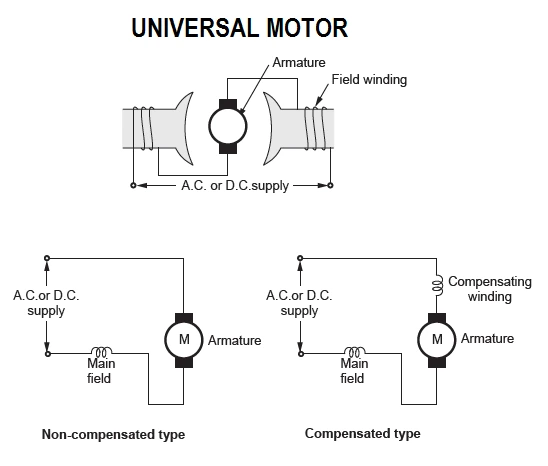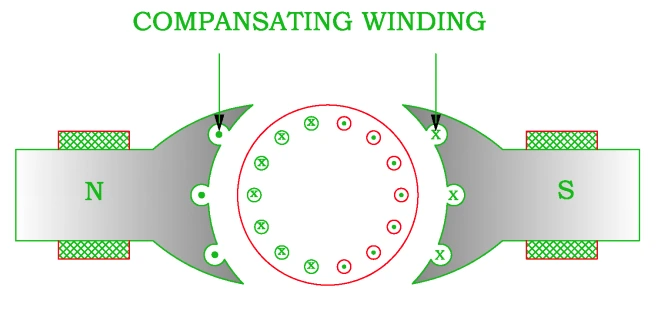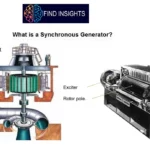
What is a Universal Motor? Working, Types & Applications
The motors which can be used with a single-phase AC source as well as a DC source of supply and voltages are called as Universal Motor. It is also known as Single Phase Series Motor. It is a commutation type motor.
What is a Universal Motor?
A universal motor is an engine that runs on both DC and AC power supplies. The features of this motor primarily include variable speed and high transmission torque. It provides a high starting torque; the speed can change, it is small in size, and cheap. The key parts are armature, field winding, stator stamping, frame and plate, and polish.
There are two basic types:
- Compensated type
- Uncompensated type
Characteristic of Universal motor
- It is similar to that of the DC series motor
- When operating from an AC supply, the series motor develops less torque.
- By interchanging connections of the fields with respect to the armature, the direction of rotation can be altered.
Universal Motor Circuit Diagram

What is a Universal Motor Working Principle?
DC Supply
A universal motor operates on either DC or single phase AC supply. When the motor is fed with a DC supply, it works as a DC series motor. When current flows in the field winding, it produces an electromagnetic field. The same current also flows from the armature conductors. When a current carrying conductor is placed in an electromagnetic field, it experiences a mechanical force. Due to this mechanical force, or torque, the rotor starts to rotate. The direction of this force is given by Fleming’s left hand rule.

AC Supply
When fed with AC supply, it still produces unidirectional torque. Because, armature winding and field winding are connected in series, they are in same phase. Hence, as polarity of AC changes periodically, the direction of current in armature and field winding reverses at the same time. Thus, direction of magnetic field and the direction of armature current reverses in such a way that the direction of force experienced by armature conductors remains same. Thus, regardless of AC or DC supply, it works on the same principle that DC series motor works.
Speed Control of Universal Motor
Speed control is done by following techniques
- One technique is used to build the engine in a system to avoid the engine from operating at no-load condition.
- A fixed resistor in the circuit is used as a speed regulator. The resistor is short-circuited unless the engine is going too fast. Then the shortening contacts open to connect the capacitor to the motor circuit.
- Speed controlling can also be achieved by an electronic controller. Some controllers use a silicone-controlled rectifier.
- Another approach is to use a gear train to minimize the speed of real load; and
- The other techniques are centrifugal system, resistance, and ground tapping.
Advantages and Disadvantages of Universal motor:
The following are the advantages and disadvantages of universal motor:
Advantages of universal motor
- High starting torque
- Very compact design if high running speeds are used.
Disadvantages
- Requires maintenance
- short life problems caused by the commutator.
Applications:
- It is used in various home appliances like vacuum cleaners, drink and food mixers, domestic sewing machine etc.
- The higher rating universal motors are used in portable drills, blenders etc
LIKE WHAT YOU’RE READING?
CHECK OUT SOME OF OUR OTHER GREAT CONTENT HERE:
- SYNCHRONOUS MOTOR STARTING METHOD
- WHY THE SYNCHRONOUS MOTOR IS NOT SELF STARTING
- LVDT- CONSTRUCTION, WORKING PRINCIPLE , APPLICATIONS, ADVANTAGES, AND DISADVANTAGES
- HOW AN IGBT WORKS?
- SCR VI CHARACTERISTICS EXPLAINED IN DETAIL
- STEP UP TRANSFORMER: DEFINITION, CONSTRUCTION, WORKING & APPLICATIONS
- LIMITATIONS OF OHM’S LAW
- STRAIN GAUGE WORKING PRINCIPLE
- WHAT IS THE ZENER DIODE? – EXPLAINED
- WHAT ARE THE USES OF CAPACITOR
- CHARACTERISTICS OF A ZENER DIODE – EXPLAINED
- VOLTAGE REGULATION BY ZENER DIODE – EXPLAINED




5 Comments